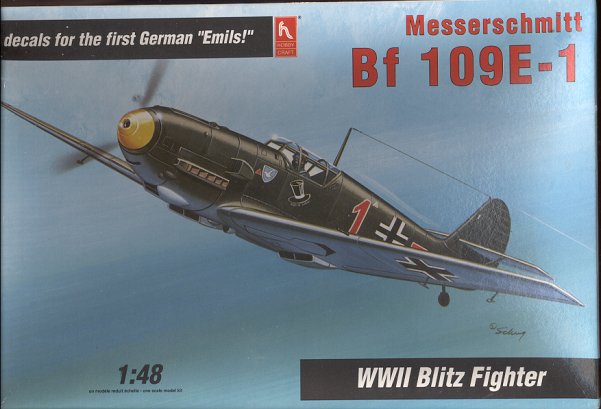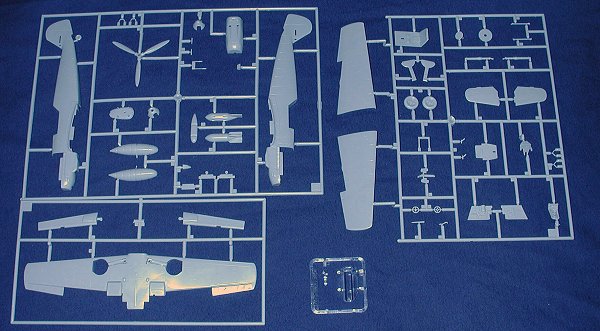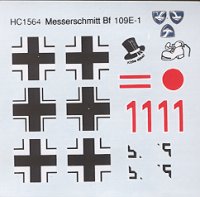
|
KIT: |
Hobbycraft 1/48 Bf-109E-1 |
|
KIT # |
1564 |
|
PRICE: |
$11.98 |
|
DECALS: |
Two aircraft |
|
REVIEW & |
|
|
NOTES: |
|

|
HISTORY |
The first production Daimler Benz powered Bf-109s were the E variants. These started with a number of preproduction aircraft, the Bf-109E-0. In the numbering system used at the time in the Luftwaffe, preproduction planes were all '-0' after the model number. Depending on the aircraft type, this could mean just one plane or a couple of dozen. The Luftwaffe used the 109E-0s in propaganda to make people think that it was the Bf-109D. In reality, the Jumo powered 109D was in some ways inferior to the previous Bf-109C in that the D used a carbureted engine where the C had fuel injection. The deception is still enough to foil many modern authors who tend to use older books as references rather than doing any actual research into the subject.
Anyway, the Bf-109E had several differences from the earlier Jumo powered aircraft other than just the engine. Because of the DB.601, the cowling was much cleaner than with the Jumo. The large under nose radiator was gone replaced by a small oil cooler radiator. The coolant radiators were embedded partially into the wings leaving little to the airflow, but able to pull in all the required cool air needed. The rest of the airframe was pretty much the same as with the earlier models. The E-1 and E-3 were built concurrently with the at about a 47-53 ratio of -1s to -3s. The difference in the two was wing armament. The E-1 had four MG 17machine guns, two in the nose and two in the wings. The E-3 had MG FF 20mmcannon in the wing and can be distinguished from the E-1 by small under wing bulges to clear the cannon feed mechanism. In all other respects the planes were identical. Though designed to carry a 20mm cannon firing through the prop hub, apparently only two nose cannon armed Bf-109E-2s were ever built with this weapon. It wasn't until the F model that the engine-mounted gun was successfully used on production 109s.
As the E-1/3 was replaced on the production line with the E-4/7, older planes were often updated with the newer canopies and a number of these planes were fitted with centerline bomb racks as E-1B fighter-bombers or Jabos. Others were modified to full E-4/7 standards if damaged badly enough in combat or accidents.
|
THE KIT |

Those who have been reading Modeling Madness for a while know that I have already built this kit. However that was over 5 years ago and it is good to take a look at what the bare kit looks like. Hobbycraft kits are not Tamiya or Hasegawa standard models, but they don't cost a Hasegawa or Tamiya price. Besides, other than a rather expensive Hasegawa kit with resin plugs, only Hobbycraft does the E-1 variant.
The kit has nicely engraved panel lines, a reasonably well equipped interior with seat, trim wheels, rudder pedals and the whole ball of wax. You also get a drop tank and bomb for the underside rack, though unless modified to the E-1B standard, they were not used on the plane. You can put those in the spares box. The kit includes separate flaps as really its only option. I whined about not having nose guns in my previous review, but must have lost them or something as they are included in the kit. The canopy is clear, but is in the closed position. I should mention that the tan color in the image above is a photo glitch and not the color of the plastic.
 Though I don't remember it, I
have had friends tell me that the canopy is also a bit too narrow for the
opening. Even if this is true and you buy an aftermarket one, with a new vac
canopy and even a new resin cockpit set you won't come to the price of a
Hasemiya kit. What will bring you up to that total is a decal sheet. This is one
of Hobbycraft's older kits in terms of decals. The ones with the kit are well
printed, but are not up to current Hobbycraft standards. Fortunately, there are
a ton of aftermarket sheets for the E-1 so finding an interesting scheme won't
be a problem. The small sheet provided gives markings for one aircraft from JG
132 just before the war and one from JG 77 in 1940. Both are painted RLM 70/71
on the upper surfaces and RLM 65 on the lower ones. The demarkation line for the
scheme was very low on the fuselage. It is possible that later builds of the E-1
were done in RLM 71/02 uppers, but I'd have a photo to make sure of that.
Though I don't remember it, I
have had friends tell me that the canopy is also a bit too narrow for the
opening. Even if this is true and you buy an aftermarket one, with a new vac
canopy and even a new resin cockpit set you won't come to the price of a
Hasemiya kit. What will bring you up to that total is a decal sheet. This is one
of Hobbycraft's older kits in terms of decals. The ones with the kit are well
printed, but are not up to current Hobbycraft standards. Fortunately, there are
a ton of aftermarket sheets for the E-1 so finding an interesting scheme won't
be a problem. The small sheet provided gives markings for one aircraft from JG
132 just before the war and one from JG 77 in 1940. Both are painted RLM 70/71
on the upper surfaces and RLM 65 on the lower ones. The demarkation line for the
scheme was very low on the fuselage. It is possible that later builds of the E-1
were done in RLM 71/02 uppers, but I'd have a photo to make sure of that.
As I mentioned in the earlier review, this is a period of time where the instruction sheet was adequate to build the kit, but gave no color information other than the exterior scheme. Old Luftwaffe modelers will know what color to do things, but new people will be left scratching their heads. On the 109E-1 the wheel wells, gear struts, and interior were RLM 02 grey with the instrument panel in RLM 66 dark grey. Wheels could be RLM 02 or black, your choice
|
CONCLUSIONS |
Bottom line. You want a relatively easy to build Bf-109 (and I'll admit that it does take a bit of modeling skill) and don't want to spend $25.00 doing it, get this kit. This particular kit is still to be found and is still $11.98. If you are a contest modeler, you won't touch it. If you are like 90% of the rest of us, you'll be quite pleased with the result of your efforts. If you want to trick it out with aftermarket, you can and it will only look better. I have always recommended the Hobbycraft 109s and still do.
|
REFERENCES |
Messerschmitt Me-109 Part 1 by Robert Michulec, AJ Press, 2001
Review kit courtesy of me and my wallet!
If you would like your product reviewed fairly and quickly by a site that has over 100,000 visitors a month, please contact me or see other details in the Note to Contributors.